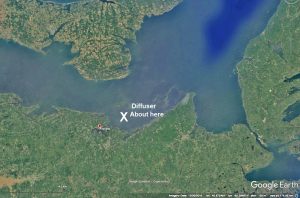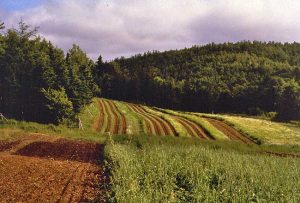
Recent aerial photo by Scott Leslie of the East Kemptville mine near Yarmouth, across the 203 highway from the Tobeatic Wilderness Area. Although it closed in 1992 and it’s been 25 years, it’s hard to see any evidence of remediation.
Click on photo for larger version
Sometimes my attempt to provide a “record of events, news and opinions on the subject of forests and forestry in Nova Scotia as they unfold, beginning on June 21, 2016″ (all admittedly biased) can be challenging. The last 10 days have been one of those times.
Here are some of the items that have caught my attention over the few days since my last post.
Mining versus protected areas, continued
Protesters object to development of Cape Breton mountain sacred to Mi’kmaq National Post, Dec 16, 2017
(The mountain) is our sacred place and it is home of our sacred being, to destroy that place for profit is the same thing as me going over to the Vatican and chipping off the gold, and the silvers and the rubies and the diamonds … and maybe taking a couple of Michelangelos home. – Elizabeth Marshall of Eskasoni First Nation
Also: Protesters gather, slow traffic to object mining projects on Kellys Mountain in Victoria County
Jeremy Fraser in Cape Breton Post, Dec 16, 2017.
More lessons in PR: the Mill

LETTER: Northern Pulp book issue definitely was not censorship
RM in The News, Dec 13, 2017, “The book by Joan Baxter is a rushed attempt to promote a narrative, not a search for truth. It seeks to inflame, not inform…We members of Local 440 are not so easily led. Ask any manager at the mill.”
Also: Joan Baxter’s book sells out before signing ends
The Advocate, Dec 13, 2017
Also: Lodge manager buoyed by community support in wake of cancelled Christmas party
The Advocate, Dec 14, 2017
The state of the forest
COMMENTARY: Stop mourning yesterday’s forests
by Gary Saunders in Chronicle Herald, in print Dec 15 (posted on web Dec 14). This is a complex piece best read directly. It can’t be summarized with a few extracts. There are snippets to satisfy everyone and displease everyone. I’m not sure where this one might land:
Even the native Mi’kmaq shunned old growth. Pileated woodpeckers, flying squirrels and pretty salamanders make poor eating. What they needed from the forest were grassy openings where berries and foliage drew edible game. Unable to fell flinty maple and beech with stone axes, they made judicial use of fire.
I am glad he said “judicial”. If we could apply the same word to clearcutting over the last 60 years, we wouldn’t be in the pickle we are in today. I expect to see some follow-up on Saunder’s piece in the Letters to the Editor. There is some discussion of it at Woods and Waters.
Clearcut refugees?
Urban deer bring pesky problems across Nova Scotia
The Chronicle Herald, Dec 14, 2017.
Mike Boudreau, human-wildlife conflict biologist with the Nova Scotia Department of Natural Resources, said there are serious repercussions to white-tailed deer wandering metropolitan streets, roaming in from parkland and any green corridors in subdivisions or fringe areas…Then there’s also a cascade effect of other, more dangerous encroachments from predators.
‘No mention that some of these visitors could be clearcut refugees.
Hemlock Vampires
A friend sent me the photo at right of a hemlock stand in SW Nova Scotia that has fallen to the wooly adelgid whose arrival we learned about only in August. The message: “This could possibly be what our old growth Hemlock stands will look like in the not so distant future.”After that I needed some good news.
Land
Huge gift hands forest in Cobequid Hills to Nature Conservancy
Chronicle Herald, Dec 15, 2017 (print ed; online Dec 14)
A Good News story to most Nova Scotians. Protection of small parcels of private land doesn’t seem to be controversial in Nova Scotia; protection of larger blocks of Crown land may be slowed by the forest industry and miners who see them as detracting from their natural resource base; at least that’s the explanation I often hear cited for the delay in formally declaring a number of areas already identified for protection.
Saltscapes: Can’t see the forest or the trees
Deborah Carr article in Dec/Jan 2018 issue of Saltscapes, print ed (or digital subscription)

Whaelghinbran Farm, NB, in 1989. I am glad to know those magnificent forests are still there. (Neighbouring land had been clearcut.) Thanks, Clark and Susan and Community Forests International.
The Independent Review
In the meantime, the Independent Review of Forestry Practices in Nova Scotia has passed the halfway mark of its allocated 6 months to conduct the review and submit a report by February 28, 2018. According to the time frame given in the Terms of Reference we are now well into Phase 2:
2. Issue Identification and Review (December-January)
• Identify major issues
• Mi’kmaq engagement
• Stakeholder, and public Input
It’s not clear how the Mi’kmaq engagement and Stakeholder, and public Input are being or will be facilitated; I have seen no announcements beyond the information on the DNR webpage for the Independent Review:
You may contact the forest practices review by sending an email to forestryreview@novascotia.ca
Prof. Lahey welcomes written submissions and the opportunity to meet directly with groups and individuals who have experience and knowledge on the topics identified for the review.
Perhaps it’s assumed that “groups and individuals who have experience and knowledge on the topics identified for the review” have already contacted the Independent Review or are known to DNR/The Independent Review and have been contacted. If not, perhaps there will be some announcement after Christmas. That leaves one month for further input and one short month to write the report.
Why do I think it’s already being drafted?
View also Independent Review posts
—————
Apologies, folks. I usually get more optimistic once the days start lengthening again, but about this one I am not so sure. I do think the premier wants an objective assessment of the validity of the disparate views of forests and forestry in NS, but I am not confident he will get it. I have lost most of the optimism about this review that I had when it was announced.
I hope I and Ralph Surette are wrong about this one.

